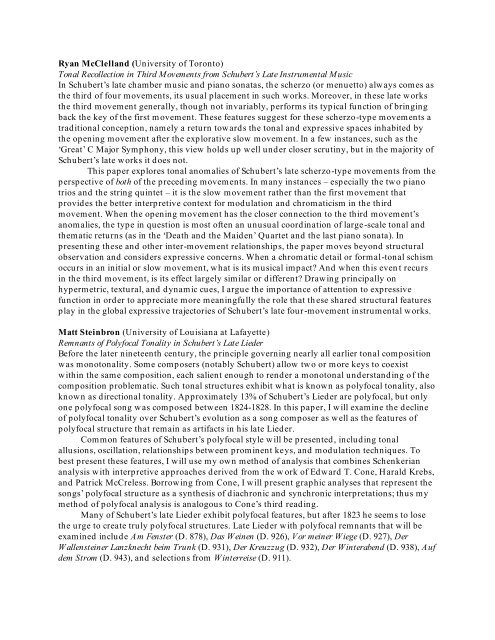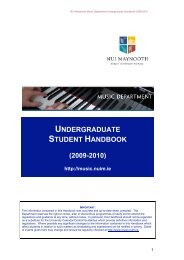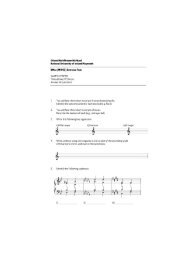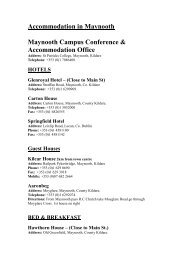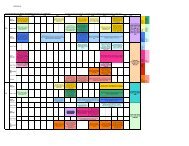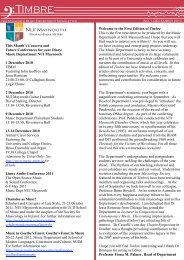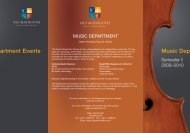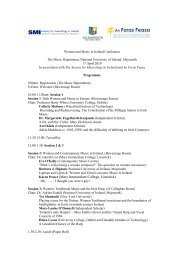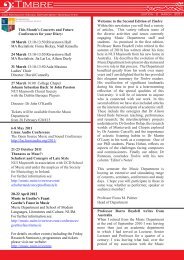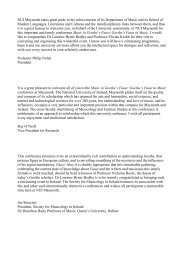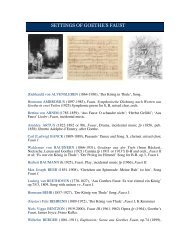Conference Booklet - Music - National University of Ireland, Maynooth
Conference Booklet - Music - National University of Ireland, Maynooth
Conference Booklet - Music - National University of Ireland, Maynooth
Create successful ePaper yourself
Turn your PDF publications into a flip-book with our unique Google optimized e-Paper software.
Ryan McClelland (<strong>University</strong> <strong>of</strong> Toronto)<br />
Tonal Recollection in Third Movements from Schubert’s Late Instrumental <strong>Music</strong><br />
In Schubert‘s late chamber music and piano sonatas, th e scherzo (or menuetto) always comes as<br />
the third <strong>of</strong> four movements, its usual placement in such works. Moreover, in these late works<br />
the third movement generally, though not invariably, performs its typical function <strong>of</strong> bringing<br />
back the key <strong>of</strong> the first m ovement. These features suggest for these scherzo-type movements a<br />
traditional conception, namely a return towards the tonal and expressive spaces inhabited by<br />
the opening movement after the explorative slow movement. In a few instances, such as the<br />
‗Great‘ C Major Symphony, this view holds up well under closer scrutiny, but in the majority <strong>of</strong><br />
Schubert‘s late works it does not.<br />
This paper explores tonal anomalies <strong>of</strong> Schubert‘s late scherzo-type movements from the<br />
perspective <strong>of</strong> both <strong>of</strong> the preceding movements. In many instances – especially the two piano<br />
trios and the string quintet – it is the slow movement rather than the first movement that<br />
provides the better interpretive context for modulation and chromaticism in the third<br />
movement. When the opening movement has the closer connection to the third movement‘s<br />
anomalies, the type in question is most <strong>of</strong>ten an unusual coordination <strong>of</strong> large-scale tonal and<br />
thematic returns (as in the ‗Death and the Maiden‘ Quartet and the last piano sonata). In<br />
presenting these and other inter-movement relationships, the paper moves beyond structural<br />
observation and considers expressive concerns. When a chromatic detail or formal-tonal schism<br />
occurs in an initial or slow movement, what is its musical impact? And when this even t recurs<br />
in the third movement, is its effect largely similar or different? Drawing principally on<br />
hypermetric, textural, and dynamic cues, I argue the importance <strong>of</strong> attention to expressive<br />
function in order to appreciate more meaningfully the role that th ese shared structural features<br />
play in the global expressive trajectories <strong>of</strong> Schubert‘s late four-movement instrumental works.<br />
Matt Steinbron (<strong>University</strong> <strong>of</strong> Louisiana at Lafayette)<br />
Remnants <strong>of</strong> Polyfocal Tonality in Schubert’s Late Lieder<br />
Before the later nineteenth century, the principle governing nearly all earlier tonal composition<br />
was monotonality. Some composers (notably Schubert) allow two or more keys to coexist<br />
within the same composition, each salient enough to render a monotonal understanding o f the<br />
composition problematic. Such tonal structures exhibit what is known as polyfocal tonality, also<br />
known as directional tonality. Approximately 13% <strong>of</strong> Schubert‘s Lieder are polyfocal, but only<br />
one polyfocal song w as composed between 1824-1828. In this paper, I will examine the decline<br />
<strong>of</strong> polyfocal tonality over Schubert‘s evolution as a song composer as well as the features <strong>of</strong><br />
polyfocal structure that remain as artifacts in his late Lieder.<br />
Common features <strong>of</strong> Schubert‘s polyfocal style will be presented, including tonal<br />
allusions, oscillation, relationships between prominent keys, and modulation techniques. To<br />
best present these features, I will use my own method <strong>of</strong> analysis that combines Schenkerian<br />
analysis with interpretive approaches derived from the w ork <strong>of</strong> Edward T. Cone, Harald Krebs,<br />
and Patrick McCreless. Borrowing from Cone, I will present graphic analyses that represent the<br />
songs‘ polyfocal structure as a synthesis <strong>of</strong> diachronic and synchronic interpretations; thus my<br />
method <strong>of</strong> polyfocal analysis is analogous to Cone‘s third reading.<br />
Many <strong>of</strong> Schubert‘s late Lieder exhibit polyfocal features, but after 1823 he seems to lose<br />
the urge to create truly polyfocal structures. Late Lieder with polyfocal remnants that will be<br />
examined include Am Fenster (D. 878), Das Weinen (D. 926), Vor meiner Wiege (D. 927), Der<br />
Wallensteiner Lanzknecht beim Trunk (D. 931), Der Kreuzzug (D. 932), Der Winterabend (D. 938), Auf<br />
dem Strom (D. 943), and selections from Winterreise (D. 911).


